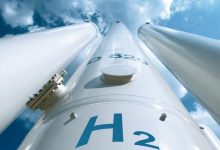Australia is set to see a massive expansion of renewable hydrogen production, after a $300 million project destined for Western Australia succeeded in securing investment funding.
The project is being developed by Perth-based company Infinite Blue Energy, which is planning to build what will become Australia’s largest hydrogen production facility using supplies of wind and solar energy.
The Arrowsmith Hydrogen Project, which will be built at a facility in the town of Dongara, located 320km north of Perth, is expected to produce 25 tonnes of green hydrogen each day, powered by wind and solar.
The project is set to include its own dedicated onsite supplies of renewable electricity, with a spokesperson for Infinite Blue Energy telling RenewEconomy that the Arrowsmith plant will be supplied by around 85MW of solar power, supplemented by 75MW of wind generation capacity.
Works on the project are expected to commence by the middle of the year. First production from the facility is planned for the final quarter of 2022.
Infinite Blue Energy hopes the mammoth project will help establish Australia as a global leader in the production and supply of zero-emissions hydrogen fuel.
“IBE is at the leading edge of Green Hydrogen and we have been able to progress the Arrowsmith Hydrogen Project by establishing partnerships with leading Australian and international companies, technology suppliers and Green Hydrogen buyers around the world,” Infinite Blue Energy CEO Stephen Gauld said.
“We are enabling access to leading-edge technology and establishing domestic and international sales agreements to spearhead our expansion plans.”
The production of renewable hydrogen has been promoted as a key solution to the need to store and transport energy while reducing global greenhouse gas emissions. Hydrogen has the potential to for use in energy storage, as well as use as a transport fuel, but has so far seen limited uptake, despite rapidly falling costs.
Gauld added that the current economic environment, impacted by the Covid-19 pandemic, was a good time to support the expansion of the Australian energy industry into innovative business opportunities.
“COVID-19 has completely changed the operational outlook for so many businesses across the country and what is now needed to be market leading is a uniquely competitive and innovative offering that has not been done before; one with a sustainable carbon footprint that can truly accelerate Australia’s economic growth in regional areas,” Gauld added.

The Arrowsmith Hydrogen project is the first of many planned by the consortium, which hopes to have many similar projects established across regional Western Australia. The company already has plans for a follow up project that will have the capacity to produce as much as 75,000Kg/day of renewable hydrogen.
“Our vision at IBE is to show the world first and foremost that Australia has the technology, skills and entrepreneurial mindset to be a true leader in the development of Green Hydrogen plants,” Gauld said.
“Through the completion of the Arrowsmith project and IBE’s innovative business model, Australia can advance its interests on the global stage as a leader in the development of ground-breaking Green Hydrogen energy solutions and accelerate the creation of a major employment strategy and industry for Australia in the immediate future.”
The company acknowledged the ramping up of government support and funding on offer to an Australian hydrogen industry, including a $70 million funding round to be offered by the Australian Renewable Energy Agency, to rapidly expand Australia’s hydrogen electrolyser capacity.
Ultimately, Infinite Blue Energy hopes to see the integration of large-scale electricity storage and generation using hydrogen, that could offer 24/7 supplies of power.
“We’re really excited by the possibilities for this project and see Green Hydrogen as a fantastic growth industry for regional Australia that stands to benefit all Australians in the years to come,” Gauld added.
In a report published by the Australian Renewable Energy Agency last week, on-site supplies of wind and solar were found to be the key to lowering the cost of renewable hydrogen production at Australian facilities.
The report also found that more must be done to increase the use of renewable hydrogen in the industry, transport and energy sectors, suggesting that the use of zero-emissions hydrogen in the production of ammonia fertilisers could help provide a source of demand for the emerging hydrogen industry.
RenewEconomy and the Smart Energy Council will be co-hosting a “virtual conference” on May 6, focusing on a renewables-led economic recovery, featuring industry leaders, analysts and advocates. More information and registration here.
RenewEconomy and its sister sites One Step Off The Grid and The Driven will continue to publish throughout the Covid-19 crisis, posting good news about technology and project development, and holding government, regulators and business to account. But as the conference market evaporates, and some advertisers pull in their budgets, readers can help by making a voluntary donation here to help ensure we can continue to offer the service free of charge and to as wide an audience as possible. Thankyou for your support.










